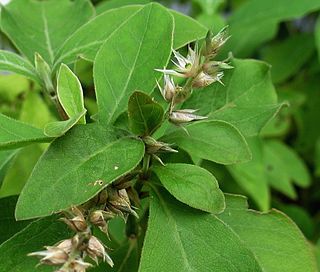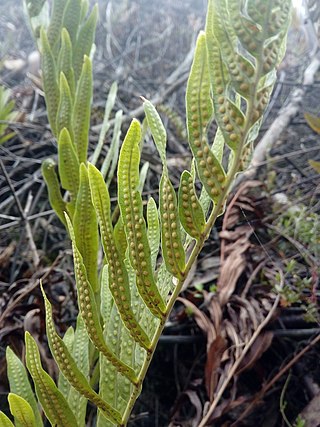The conservation status of a group of organisms indicates whether the group still exists and how likely the group is to become extinct in the near future. Many factors are taken into account when assessing conservation status: not simply the number of individuals remaining, but the overall increase or decrease in the population over time, breeding success rates, and known threats. Various systems of conservation status are in use at international, multi-country, national and local levels, as well as for consumer use such as sustainable seafood advisory lists and certification. The two international systems are by the International Union for Conservation of Nature (IUCN) and The Convention on International Trade in Endangered Species of Wild Fauna and Flora (CITES).
Achyrocline mollis is a species of flowering plant in the Gnaphaliae tribe of the family Asteraceae. It is found only in Ecuador, Colombia and possibly Perú. Its natural habitat is subtropical or tropical moist montane forests. It is threatened by habitat loss.
Fleischmannia obscurifolia is a species of flowering plant in the family Asteraceae. It is found in Ecuador and Colombia. Its natural habitats are subtropical or tropical moist lowland forests and subtropical or tropical moist montane forests. It is threatened by habitat loss.
Dendrophorbium floribundum is a species of flowering plant in the family Asteraceae. It is found only in Ecuador. Its natural habitat is subtropical or tropical moist montane forests. It is threatened by habitat loss.
Draba splendens is a species of flowering plant in the family Brassicaceae. It is found only in Ecuador. Its natural habitats are subtropical or tropical high-altitude grassland and rocky areas. It is threatened by habitat loss.
Tectiphiala ferox, or palmiste bouglé, is a species of flowering plant in the family Arecaceae. It is endemic to Mauritius.

Achyranthes mutica is a species of plant in the family Amaranthaceae. It is endemic to Hawaii. It is a perennial shrub that grows up to 2 ft (0.61 m) tall. Its natural habitats are dry forests and subtropical or tropical dry shrubland. It is threatened by habitat loss.
Alternanthera grandis is a species of plant in the family Amaranthaceae. It is endemic to Ecuador. Its natural habitats are:
Austroblechnum divergens, synonyms including Blechnum divergens, Blechnum rimbachii and Blechnum floresii, is a species of fern in the family Blechnaceae.
Serpocaulon lasiopus is a species of fern in the family Polypodiaceae. It is widespread in South America. Under the synonym Polypodium argyrolepis, it was regarded as endemic to Ecuador and threatened by habitat loss.
Polypodium chionolepis is a species of fern in the family Polypodiaceae. It is endemic to Ecuador. Its natural habitat is subtropical or tropical moist montane forests. It is threatened by habitat loss.
Serpocaulon latissimum is a species of fern in the family Polypodiaceae. It is endemic to Ecuador. Its natural habitat is subtropical or tropical moist lowland forests. It is threatened by habitat loss.
Serpocaulon eleutherophlebium is a species of fern in the family Polypodiaceae. It is native to Costa Rica, Panama, Colombia, Ecuador and Venezuela. Under the synonym Polypodium mindense, it was regarded as endemic to Ecuador.

Pleopeltis murorum is a species of fern in the family Polypodiaceae. It is native to parts of Central and Southern America. Under the synonym Polypodium mixtum, it was regarded as endemic to Ecuador and threatened by habitat loss.
Moranopteris achilleifolia is a species of fern in the family Polypodiaceae. It is native to Brazil and Argentina. It is also placed in the genus Grammitis.
Pecluma dulcis is a species of fern in the family Polypodiaceae. It has a widespread native distribution from Mexico to Southern America. Under the synonym Polypodium quitense, it was regarded as endemic to Ecuador and threatened by habitat loss.

Serpocaulon sessilifolium is a species of fern in the family Polypodiaceae. It is native to Costa Rica and northern and western South America. Under the synonym Polypodium rimbachii, it was regarded as endemic to Ecuador and threatened by habitat loss.
Serpocaulon fraxinifolium is a species of fern in the family Polypodiaceae. It is native to Mexico, Central and South America. Under the synonym Polypodium scutulatum , it was regarded as endemic to Ecuador and threatened by habitat loss.
Pleopeltis segregata is a species of fern in the family Polypodiaceae. It is endemic to Ecuador. Its natural habitat is subtropical or tropical moist montane forests.
Tectaria chimborazensis is a species of fern in the family Tectariaceae. It is endemic to Ecuador.



